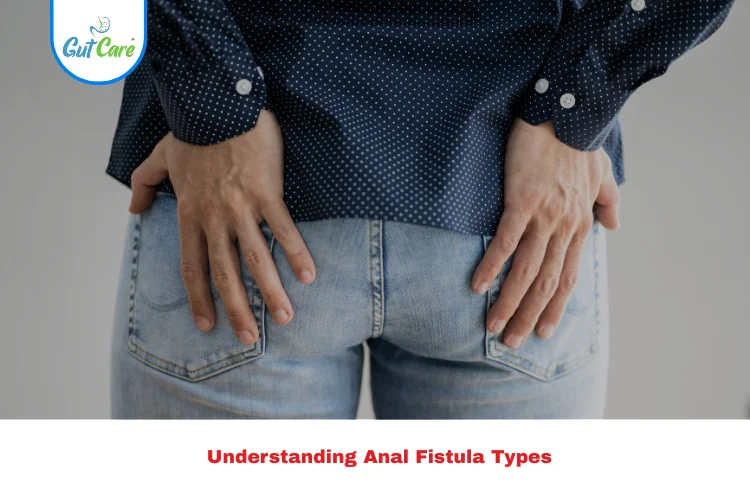Whether you’re suffering from an anal fistula or simply seeking straightforward information about the condition, it is important to understand the various types of anal fistulas. The types of anal fistula differ based on their location, complexness, and muscles involved, and can change how we treat the anal fistula.
Dr. Yuvrajsingh Gehlot, fistula expert at Gutcare Clinics in Bangalore, endeavors to diagnose and classify anal fistula types accurately to further provide patients with effective and safe treatments.
What Is an Anal Fistula?
An anal fistula is a small tunnel or tract that connects an infected gland in the anal canal to skin around the anus. It usually occurs after an abscess (collection of pus) forms and does not heal correctly.But the path this tunnel takes determines the type of fistula — and that path influences treatment decisions.
The Four Main Anal Fistula Types
1. Intersphincteric Fistula:
Anatomy and Path:
An intersphincteric fistula occurs between both sphincters, the internal and external sphincters. We traced a path from the infected anal gland in the anal canal, through the internal sphincter muscle, and opened on the skin near the anus and did not cross the external sphincter.
Significance:
Given the tract is intersphincteric, it is passive to the external sphincter, and therefore spares the external sphincter, an important functional element for bowel control. This is why intersphincteric fistula is the easiest fistula to treat, usually with simple surgical intervention.
Symptoms:
Mild to moderate pain near the anus
Pus or blood discharge
Swelling and tenderness around the fistula opening
Treatment Insight:
Because the sphincter muscle isn’t damaged, procedures like fistulotomy (cutting open the fistula) have a high success rate and low risk of incontinence.
2. Transsphincteric Fistula: Crossing the Muscle Barrier
Anatomy and Path:
This fistula starts in the anal canal but crosses both the internal and external sphincter muscles to reach the skin.
Why It Matters:
Since the fistula cuts through the external sphincter muscle — which controls voluntary bowel movement — treatment requires caution to avoid weakening or damaging this muscle.
Symptoms:
Noticeable pain and swelling around the anus
More frequent pus discharge or foul smell
Possible recurrent abscess formation
Treatment Insight:
Dr. Yuvrajsingh Gehlot emphasizes careful surgical approaches such as seton placement (a thread to keep the fistula open and allow drainage) or advancement flap techniques to preserve sphincter function.
3. Suprasphincteric Fistula: A Complex, High-Risk Path
Anatomy and Pathology:
A suprasphincteric fistula starts between the internal sphincter and external sphincter; then it continues upward, looping over the top of the external sphincter muscle and subsequently descends and opens on the skin in the perianal region. This has the effect of creating a longer and curved fistula tract.
Why It Is Important:
Since the fistula is situated above the external sphincter, performing the surgical procedure involves the inherent risk of damage to the external sphincter muscle. It is less common but requires an advanced level of skill. Experience is critical.
Symptoms:
Severe anal pain and swelling
Chronic pus drainage and skin irritation
Recurring abscesses and infections
Treatment:
Surgical treatment is more complicated and requires advanced, often multistep repair techniques. Dr. Yuvrajsingh Gehlot at Gutcare Clinics has the experience to minimize the possibility of affecting anal continence while excising the fistula.
4. Extrasphincteric Fistula: The Unusual and Severe Variation
Anatomy and Path:
Extrasphincteric fistulas do not traverse the sphincter directly. They begin higher up, either from the rectum or sigmoid colon and track downward through the pelvic floor muscles to the skin near the anus.
Why It is Important:
This type of fistula is rare and typically arises after certain types of trauma, an existing inflammatory bowel diagnosis, or prior surgeries. Because the fistula occurs from somewhere higher up inside the bowel, diagnosis and treatment can be challenging for the patients and their use of complex surgical procedures may be required.
Symptoms:
– Persistent, severe and debilitating anal or pelvic pain
– Persistent discharge, and possible fever if infected
– A history of existing bowel disease, and/or abscess or prior trauma
Treatment Perspective:
Extrasphincteric fistulas are treated with surgical procedures that often involve sophisticated and complex surgical management with multi-modal medical management to follow for other bowel diseases as needed. Appropriate establishing of care for complex cases at Gutcare Clinics with properly trained clinicians is essential.
How Are Anal Fistula Types Diagnosed?
Diagnosis begins with physical examination and history taking, however typically requires imaging:
MRI (Magnetic Resonance Imaging): the gold standard for imaging the fistula tract and sphincter involvement.
Endoanal Ultrasound: Provides a mapping of the fistula path in relation to the muscles.
Final Thoughts
It is important to know all the different types of anal fistulas to understand them better as a patient or a physician. Each type has a unique presentation from the simple intersphincteric fistula to the complex extrasphincteric fistula, and therefore a different treatment pathway.
If you have been experiencing any symptoms such as pain, swelling or discharge around your anus, do not continue to self-diagnose, contact a professional as soon as you can.
FAQs : Anal Fistula Types
1. What are the four primary anal fistula types?
The four main types of anal fistulas are intersphincteric, transsphincteric, suprasphincteric and extrasphincteric, all defined by their path in relation to the anal sphincter muscles.
2. What is the type of anal fistula measured most frequently and easily treated?
It is the intersphincteric type, the most common type of anal fistula, and overall the least complicated and easiest one to treat.
3. How does the anal fistula types impact treatment?
The type of fistula determines the approach and treatment, these ranges from intersphincteric (straight forward) to suprasphincteric and extrasphincteric, which are much more complex, the latter types require more surgical technique to reduce risks.
4. Why should I see a specialist, regarding anal fistula?
An accurate classification of your anal fistula and an experienced specialist in treating anal fistulas is paramount, as they can reduce the chance of recurrence and complications, including worse, of anal incontinence.




